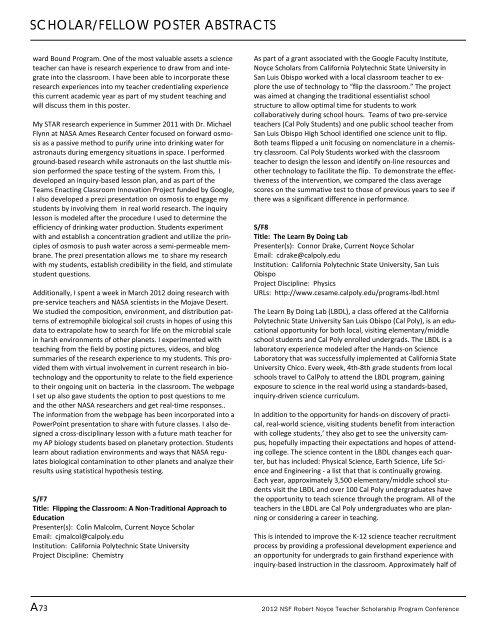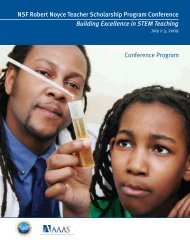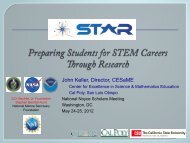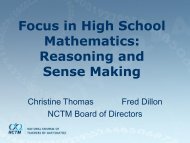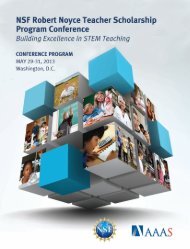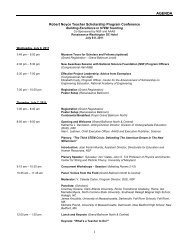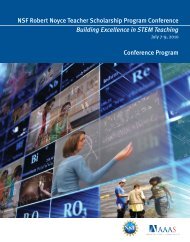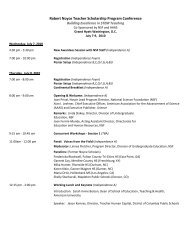SCHOLAR/FELLOW POSTER ABSTRACTSward Bound <strong>Program</strong>. One of the most valuable assets a scienceteacher can have is research experience to draw from and integrateinto the classroom. I have been able to incorporate theseresearch experiences into my teacher credentialing experiencethis current academic year as part of my student teaching andwill discuss them in this poster.My STAR research experience in Summer 2011 with Dr. MichaelFlynn at NASA Ames Research Center focused on forward osmosisas a passive method to purify urine into drinking water forastronauts during emergency situations in space. I performedground‐based research while astronauts on the last shuttle missionperformed the space testing of the system. From this, Ideveloped an inquiry‐based lesson plan, and as part of theTeams Enacting Classroom Innovation Project funded by Google,I also developed a prezi presentation on osmosis to engage mystudents by involving them in real world research. <strong>The</strong> inquirylesson is modeled after the procedure I used to determine theefficiency of drinking water production. Students experimentwith and establish a concentration gradient and utilize the principlesof osmosis to push water across a semi‐permeable membrane.<strong>The</strong> prezi presentation allows me to share my researchwith my students, establish credibility in the field, and stimulatestudent questions.Additionally, I spent a week in March <strong>2012</strong> doing research withpre‐service teachers and NASA scientists in the Mojave Desert.We studied the composition, environment, and distribution patternsof extremophile biological soil crusts in hopes of using thisdata to extrapolate how to search for life on the microbial scalein harsh environments of other planets. I experimented withteaching from the field by posting pictures, videos, and blogsummaries of the research experience to my students. This providedthem with virtual involvement in current research in biotechnologyand the opportunity to relate to the field experienceto their ongoing unit on bacteria in the classroom. <strong>The</strong> webpageI set up also gave students the option to post questions to meand the other NASA researchers and get real‐time responses..<strong>The</strong> information from the webpage has been incorporated into aPowerPoint presentation to share with future classes. I also designeda cross‐disciplinary lesson with a future math teacher formy AP biology students based on planetary protection. Studentslearn about radiation environments and ways that NASA regulatesbiological contamination to other planets and analyze theirresults using statistical hypothesis testing.S/F7Title: Flipping the Classroom: A Non‐Traditional Approach toEducationPresenter(s): Colin Malcolm, Current <strong>Noyce</strong> ScholarEmail: cjmalcol@calpoly.eduInstitution: California Polytechnic State UniversityProject Discipline: ChemistryAs part of a grant associated with the Google Faculty Institute,<strong>Noyce</strong> Scholars from California Polytechnic State University inSan Luis Obispo worked with a local classroom teacher to explorethe use of technology to “flip the classroom.” <strong>The</strong> projectwas aimed at changing the traditional essentialist schoolstructure to allow optimal time for students to workcollaboratively during school hours. Teams of two pre‐serviceteachers (Cal Poly Students) and one public school teacher fromSan Luis Obispo High School identified one science unit to flip.Both teams flipped a unit focusing on nomenclature in a chemistryclassroom. Cal Poly Students worked with the classroomteacher to design the lesson and identify on‐line resources andother technology to facilitate the flip. To demonstrate the effectivenessof the intervention, we compared the class averagescores on the summative test to those of previous years to see ifthere was a significant difference in performance.S/F8Title: <strong>The</strong> Learn By Doing LabPresenter(s): Connor Drake, Current <strong>Noyce</strong> ScholarEmail: cdrake@calpoly.eduInstitution: California Polytechnic State University, San LuisObispoProject Discipline: PhysicsURLs: http://www.cesame.calpoly.edu/programs‐lbdl.html<strong>The</strong> Learn By Doing Lab (LBDL), a class offered at the CaliforniaPolytechnic State University San Luis Obispo (Cal Poly), is an educationalopportunity for both local, visiting elementary/middleschool students and Cal Poly enrolled undergrads. <strong>The</strong> LBDL is alaboratory experience modeled after the Hands‐on ScienceLaboratory that was successfully implemented at California StateUniversity Chico. Every week, 4th‐8th grade students from localschools travel to CalPoly to attend the LBDL program, gainingexposure to science in the real world using a standards‐based,inquiry‐driven science curriculum.In addition to the opportunity for hands‐on discovery of practical,real‐world science, visiting students benefit from interactionwith college students,’ they also get to see the university campus,hopefully impacting their expectations and hopes of attendingcollege. <strong>The</strong> science content in the LBDL changes each quarter,but has included: Physical Science, Earth Science, Life Scienceand Engineering ‐ a list that that is continually growing.Each year, approximately 3,500 elementary/middle school studentsvisit the LBDL and over 100 Cal Poly undergraduates havethe opportunity to teach science through the program. All of theteachers in the LBDL are Cal Poly undergraduates who are planningor considering a career in teaching.This is intended to improve the K‐12 science teacher recruitmentprocess by providing a professional development experience andan opportunity for undergrads to gain firsthand experience withinquiry‐based instruction in the classroom. Approximately half ofA73<strong>2012</strong> NSF <strong>Robert</strong> <strong>Noyce</strong> Teacher <strong>Scholarship</strong> <strong>Program</strong> <strong>Conference</strong>
SCHOLAR/FELLOW POSTER ABSTRACTSNot far from Disneyland is Anaheim High School, an urban schoolwhere more than half of the students are English language learnthe<strong>Noyce</strong> Scholars at Cal Poly participate in the LBDL prior toapplying to <strong>Noyce</strong>, and they cite LBDL as an important influenceon their decision to commit to science education. <strong>The</strong> LBDL is anextremely valuable experience both to the undergrad studentswho teach the lessons and to the younger students who attendand experience the lessons. For me personally, being a part ofthe LBDL at Cal Poly was my first step toward pursuing a careeras a STEM teacher.S/F9Title: Patterns of cryptic and Aposematic Coloration in CostaRican Moths: Introducing Inquiry into the ClassroomPresenter(s): Vicky Giese, Current <strong>Noyce</strong> ScholarEmail: vgiese@calpoly.eduInstitution: California Polytechnic University, San Luis ObispoProject Discipline: Ecology<strong>The</strong> Organization for Tropical Studies, an NSF‐funded programhoused at Duke University, coordinates the NAPIRE <strong>Program</strong>which provides a unique opportunity for field research in thetropics to undergraduate students from the United States andthe Pacific Islands. I was one of 17 student interns chosen toconduct independent field research in Costa Rica during thesummer of 2011. My research examined cryptic and aposematiccoloration in moths at two locations within the Las Cruces BiologicalResearch Station and one location at the Las Alturas BiologicalResearch Station. A black light was attached to a whitefabric to attract moths, which were then photographed and collectedat each site. Images of moths were sorted into categoriesbased on shape and color. Differences between the numbers ofmoth types in the categories and between collection sites weretested using chi square analysis and were statistically significantat P< 0.05. Some cryptic moth species were prepared for the LasCruces Biological Research Station insect collection. As a <strong>Noyce</strong>Scholar, I hope to make an important contribution to the scienceeducation system by being involved in authentic research activitiesboth before and after I begin teaching. As a future scienceteacher, I want to generate excitement that will lead students topursue science careers. It is my desire to bring education andresearch together in the classroom, and I intend to engage studentsin authentic research by including more inquiry based activities.Students will have increased exposure to real worldscience and thus develop skills needed for careers in science andtechnology and post‐secondary education.S/F10Title: <strong>The</strong> STEAM Advisory Board: A Win‐Win‐Win‐Win SituationPresenter(s): Joaquin Alvarado, Former <strong>Noyce</strong> ScholarEmail: joaquin.alvarado@sausd.usInstitution: California State University, FresnoSchool Name & District Currently Teaching: Century High School,Santa Ana Unified School DistrictProject Discipline: Science, Technology, Engineering, Arts, MathURLs: http://www.csufresno.edu/smec/http://www.sausd.us/centurySTEM education has been a hot topic for some time now. Highneeds schools have a difficult time providing to students who areinterested in STEM related careers the opportunities for exposureto such jobs. California State University, Fresno has madeSTEM education a focal point and has trained its <strong>Noyce</strong> Scholarsto embrace this push for technological integration. Coming outof this program, I sought to help my school site become a modelfor STEM education. I have been fortunate to work with a greatteam at Century High School in Santa Ana, and we have workedvery hard to create an advisory board that works together toensure that our students have the greatest chance of succeedingin STEM related fields.<strong>The</strong> STEAM Advisory Boardat Century has taken all of the goalsof STEM education and has added Art. <strong>The</strong> board consists ofstudents, teachers, administrators, parents, and business professionalswho all have an interest in creating student access toengaging STEAM education. In its first year, the STEAM advisoryboard has received support from organizations such as NorthropGrumman, Ingram Micro, Rapid Tech, and the University of California,Irvine. We have created a new STEAM academy that willbegin next year and will have all teachers tailor their curriculumto have a STEAM focus. Parents are spreading the word aboutour academy and have had an active part in designing our curriculum.Our business partners have graciously donated theirtime and provided us with internship and job shadowing opportunitiesto which our population would not otherwise have access.<strong>The</strong> STEAM Advisory Board has allowed businesses and collegesto give their input as to which skills our students should leavewith in order to achieve success in a STEAM related field. It hasallowed our teachers to place emphasis on these skills duringtheir curriculum planning. It has given parents an opportunityto take an active role in their child’s education. Finally, it hasprovided our underrepresented, high needs students with opportunitiesto gain exposure to careers related to Science, Technology,Engineering, Art, and Math.S/F11Title: Project MT2 Three‐Fold Impact at Anaheim High SchoolPresenter(s): Thomas Duarte, Master Teaching FellowEmail: duarte_t@auhsd.usInstitution: California State University, FullertonSchool Name & District Currently Teaching: Anaheim Union HighSchool DistrictProject Discipline: Mathematics<strong>2012</strong> NSF <strong>Robert</strong> <strong>Noyce</strong> Teacher <strong>Scholarship</strong> <strong>Program</strong> <strong>Conference</strong>A74
- Page 1 and 2:
NSF Robert Noyce Teacher Scholarshi
- Page 3 and 4:
NSF Robert Noyce Teacher Scholarshi
- Page 5 and 6:
CONTENTSAbout the NSF Robert Noyce
- Page 7 and 8:
AGENDAWEDNESDAY, MAY 23, 20123:30 p
- Page 9 and 10:
HOTEL FLOOR PLANS2012 NSF Robert No
- Page 11 and 12:
SPEAKER BIOGRAPHIESL’Oreal USA an
- Page 14 and 15:
WORKSHOP ABSTRACTSSession I: Thursd
- Page 16 and 17:
WORKSHOP ABSTRACTSTarget Audience:
- Page 18 and 19:
WORKSHOP ABSTRACTS1.8 Preparing Noy
- Page 20 and 21:
WORKSHOP ABSTRACTStutorials for usi
- Page 22 and 23:
WORKSHOP ABSTRACTSentation, three o
- Page 24 and 25:
WORKSHOP ABSTRACTS2.9 Science NetLi
- Page 26 and 27:
WORKSHOP ABSTRACTS2.14 Understandin
- Page 31 and 32:
WORKSHOP ABSTRACTSThis session will
- Page 33:
WORKSHOP ABSTRACTSColleges for Teac
- Page 36 and 37:
WORKSHOP ABSTRACTSlesson and will p
- Page 38 and 39:
PI POSTER ABSTRACTS1Title: Teachers
- Page 40 and 41:
PI POSTER ABSTRACTSJulie A. Luft, A
- Page 42 and 43:
PI POSTER ABSTRACTSClinical experie
- Page 44 and 45:
PI POSTER ABSTRACTSon topics includ
- Page 46 and 47:
PI POSTER ABSTRACTSof the group at
- Page 48 and 49:
PI POSTER ABSTRACTSopportunities. E
- Page 50 and 51:
PI POSTER ABSTRACTS3. Partnership w
- Page 52 and 53:
PI POSTER ABSTRACTSpated in four ty
- Page 54 and 55:
PI POSTER ABSTRACTS41Title: Teacher
- Page 56 and 57:
PI POSTER ABSTRACTSpost‐baccalaur
- Page 58 and 59:
PI POSTER ABSTRACTSThe internships
- Page 60 and 61: PI POSTER ABSTRACTSin the degree pr
- Page 62 and 63: PI POSTER ABSTRACTSPresenter(s): Ro
- Page 64 and 65: PI POSTER ABSTRACTSSanthi Prabahar,
- Page 66 and 67: PI POSTER ABSTRACTSNicholle Stark,
- Page 68 and 69: PI POSTER ABSTRACTSprograms and dis
- Page 70 and 71: PI POSTER ABSTRACTSresulting in tea
- Page 72 and 73: PI POSTER ABSTRACTSyears. We have m
- Page 74 and 75: PI POSTER ABSTRACTSschool district,
- Page 76 and 77: PI POSTER ABSTRACTS95Title: The Noy
- Page 78 and 79: PI POSTER ABSTRACTS101Title: SUNY C
- Page 80 and 81: PI POSTER ABSTRACTSresources and su
- Page 82 and 83: PI POSTER ABSTRACTSThis project als
- Page 84 and 85: PI POSTER ABSTRACTSThe UCR Noyce Sc
- Page 86 and 87: PI POSTER ABSTRACTSInstitution: Uni
- Page 88 and 89: PI POSTER ABSTRACTSedge through the
- Page 90 and 91: PI POSTER ABSTRACTSand program cont
- Page 92 and 93: PI POSTER ABSTRACTS136Title: Title:
- Page 94 and 95: PI POSTER ABSTRACTSIn addition, the
- Page 96 and 97: PI POSTER ABSTRACTSgoals for next y
- Page 98 and 99: PI POSTER ABSTRACTS152Title: Univer
- Page 100 and 101: PI POSTER ABSTRACTSCo‐PI(s): Susa
- Page 102 and 103: PI POSTER ABSTRACTSwork samples fro
- Page 104 and 105: PI POSTER ABSTRACTSPresenter(s): Mi
- Page 106 and 107: PI POSTER ABSTRACTSThe action resea
- Page 108 and 109: PI POSTER ABSTRACTSin‐service tea
- Page 112 and 113: SCHOLAR/FELLOW POSTER ABSTRACTSers
- Page 114 and 115: SCHOLAR/FELLOW POSTER ABSTRACTSS/F1
- Page 116 and 117: SCHOLAR/FELLOW POSTER ABSTRACTScert
- Page 118 and 119: SCHOLAR/FELLOW POSTER ABSTRACTSThis
- Page 120 and 121: SCHOLAR/FELLOW POSTER ABSTRACTSS/F4
- Page 122 and 123: SCHOLAR/FELLOW POSTER ABSTRACTSS/F5
- Page 124 and 125: SCHOLAR/FELLOW POSTER ABSTRACTSthe
- Page 127 and 128: POSTER ABSTRACT INDEXAAbraham, Larr
- Page 129 and 130: POSTER ABSTRACT INDEXEscalante, Mic
- Page 131 and 132: POSTER ABSTRACT INDEXLandon, Laurie
- Page 133 and 134: POSTER ABSTRACT INDEXRodriguez, Jen
- Page 135: POSTER ABSTRACT INDEXZZaikowski, Lo


